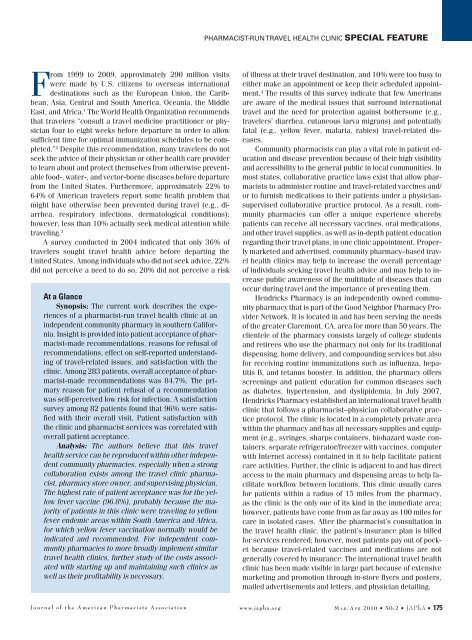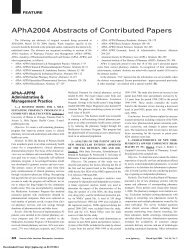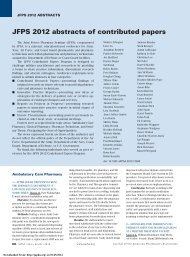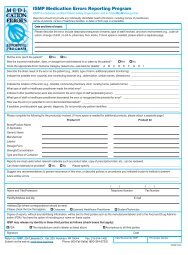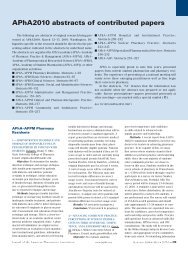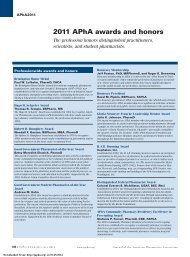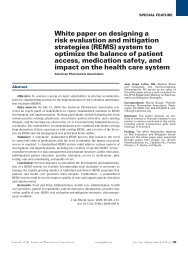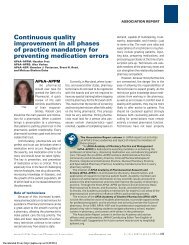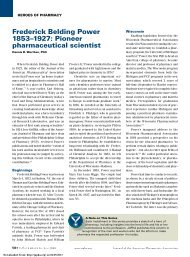Measuring outcomes of a pharmacist-run travel health clinic located ...
Measuring outcomes of a pharmacist-run travel health clinic located ...
Measuring outcomes of a pharmacist-run travel health clinic located ...
Create successful ePaper yourself
Turn your PDF publications into a flip-book with our unique Google optimized e-Paper software.
From 1999 to 2009, approximately 290 million visits<br />
were made by U.S. citizens to overseas international<br />
destinations such as the European Union, the Caribbean,<br />
Asia, Central and South America, Oceania, the Middle<br />
East, and Africa. 1 The World Health Organization recommends<br />
that <strong>travel</strong>ers “consult a <strong>travel</strong> medicine practitioner or physician<br />
four to eight weeks before departure in order to allow<br />
sufficient time for optimal immunization schedules to be completed.”<br />
2 Despite this recommendation, many <strong>travel</strong>ers do not<br />
seek the advice <strong>of</strong> their physician or other <strong>health</strong> care provider<br />
to learn about and protect themselves from otherwise preventable<br />
food-, water-, and vector-borne diseases before departure<br />
from the United States. Furthermore, approximately 22% to<br />
64% <strong>of</strong> American <strong>travel</strong>ers report some <strong>health</strong> problem that<br />
might have otherwise been prevented during <strong>travel</strong> (e.g., diarrhea,<br />
respiratory infections, dermatological conditions);<br />
however, less than 10% actually seek medical attention while<br />
<strong>travel</strong>ing. 3<br />
A survey conducted in 2004 indicated that only 36% <strong>of</strong><br />
<strong>travel</strong>ers sought <strong>travel</strong> <strong>health</strong> advice before departing the<br />
United States. Among individuals who did not seek advice, 22%<br />
did not perceive a need to do so, 20% did not perceive a risk<br />
At a Glance<br />
Synopsis: The current work describes the experiences<br />
<strong>of</strong> a <strong>pharmacist</strong>-<strong>run</strong> <strong>travel</strong> <strong>health</strong> <strong>clinic</strong> at an<br />
independent community pharmacy in southern California.<br />
Insight is provided into patient acceptance <strong>of</strong> <strong>pharmacist</strong>-made<br />
recommendations, reasons for refusal <strong>of</strong><br />
recommendations, effect on self-reported understanding<br />
<strong>of</strong> <strong>travel</strong>-related issues, and satisfaction with the<br />
<strong>clinic</strong>. Among 283 patients, overall acceptance <strong>of</strong> <strong>pharmacist</strong>-made<br />
recommendations was 84.7%. The primary<br />
reason for patient refusal <strong>of</strong> a recommendation<br />
was self-perceived low risk for infection. A satisfaction<br />
survey among 82 patients found that 96% were satisfied<br />
with their overall visit. Patient satisfaction with<br />
the <strong>clinic</strong> and <strong>pharmacist</strong> services was correlated with<br />
overall patient acceptance.<br />
Analysis: The authors believe that this <strong>travel</strong><br />
<strong>health</strong> service can be reproduced within other independent<br />
community pharmacies, especially when a strong<br />
collaboration exists among the <strong>travel</strong> <strong>clinic</strong> <strong>pharmacist</strong>,<br />
pharmacy store owner, and supervising physician.<br />
The highest rate <strong>of</strong> patient acceptance was for the yellow<br />
fever vaccine (96.8%), probably because the majority<br />
<strong>of</strong> patients in this <strong>clinic</strong> were <strong>travel</strong>ing to yellow<br />
fever endemic areas within South America and Africa,<br />
for which yellow fever vaccination normally would be<br />
indicated and recommended. For independent community<br />
pharmacies to more broadly implement similar<br />
<strong>travel</strong> <strong>health</strong> <strong>clinic</strong>s, further study <strong>of</strong> the costs associated<br />
with starting up and maintaining such <strong>clinic</strong>s as<br />
well as their pr<strong>of</strong>itability is necessary.<br />
PHARMACIST-RUn TRAvEL HEALTH CLInIC SPECIAL FEATURE<br />
<strong>of</strong> illness at their <strong>travel</strong> destination, and 10% were too busy to<br />
either make an appointment or keep their scheduled appointment.<br />
4 The results <strong>of</strong> this survey indicate that few Americans<br />
are aware <strong>of</strong> the medical issues that surround international<br />
<strong>travel</strong> and the need for protection against bothersome (e.g.,<br />
<strong>travel</strong>ers’ diarrhea, cutaneous larva migrans) and potentially<br />
fatal (e.g., yellow fever, malaria, rabies) <strong>travel</strong>-related diseases.<br />
Community <strong>pharmacist</strong>s can play a vital role in patient education<br />
and disease prevention because <strong>of</strong> their high visibility<br />
and accessibility to the general public in local communities. In<br />
most states, collaborative practice laws exist that allow <strong>pharmacist</strong>s<br />
to administer routine and <strong>travel</strong>-related vaccines and/<br />
or to furnish medications to their patients under a physiciansupervised<br />
collaborative practice protocol. As a result, community<br />
pharmacies can <strong>of</strong>fer a unique experience whereby<br />
patients can receive all necessary vaccines, oral medications,<br />
and other <strong>travel</strong> supplies, as well as in-depth patient education<br />
regarding their <strong>travel</strong> plans, in one <strong>clinic</strong> appointment. Properly<br />
marketed and advertised, community pharmacy–based <strong>travel</strong><br />
<strong>health</strong> <strong>clinic</strong>s may help to increase the overall percentage<br />
<strong>of</strong> individuals seeking <strong>travel</strong> <strong>health</strong> advice and may help to increase<br />
public awareness <strong>of</strong> the multitude <strong>of</strong> diseases that can<br />
occur during <strong>travel</strong> and the importance <strong>of</strong> preventing them.<br />
Hendricks Pharmacy is an independently owned community<br />
pharmacy that is part <strong>of</strong> the Good Neighbor Pharmacy Provider<br />
Network. It is <strong>located</strong> in and has been serving the needs<br />
<strong>of</strong> the greater Claremont, CA, area for more than 50 years. The<br />
clientele <strong>of</strong> the pharmacy consists largely <strong>of</strong> college students<br />
and retirees who use the pharmacy not only for its traditional<br />
dispensing, home delivery, and compounding services but also<br />
for receiving routine immunizations such as influenza, hepatitis<br />
B, and tetanus booster. In addition, the pharmacy <strong>of</strong>fers<br />
screenings and patient education for common diseases such<br />
as diabetes, hypertension, and dyslipidemia. In July 2007,<br />
Hendricks Pharmacy established an international <strong>travel</strong> <strong>health</strong><br />
<strong>clinic</strong> that follows a <strong>pharmacist</strong>–physician collaborative practice<br />
protocol. The <strong>clinic</strong> is <strong>located</strong> in a completely private area<br />
within the pharmacy and has all necessary supplies and equipment<br />
(e.g., syringes, sharps containers, biohazard waste containers,<br />
separate refrigerator/freezer with vaccines, computer<br />
with Internet access) contained in it to help facilitate patient<br />
care activities. Further, the <strong>clinic</strong> is adjacent to and has direct<br />
access to the main pharmacy and dispensing areas to help facilitate<br />
workflow between locations. This <strong>clinic</strong> usually cares<br />
for patients within a radius <strong>of</strong> 15 miles from the pharmacy,<br />
as the <strong>clinic</strong> is the only one <strong>of</strong> its kind in the immediate area;<br />
however, patients have come from as far away as 100 miles for<br />
care in isolated cases. After the <strong>pharmacist</strong>’s consultation in<br />
the <strong>travel</strong> <strong>health</strong> <strong>clinic</strong>, the patient’s insurance plan is billed<br />
for services rendered; however, most patients pay out <strong>of</strong> pocket<br />
because <strong>travel</strong>-related vaccines and medications are not<br />
generally covered by insurance. The international <strong>travel</strong> <strong>health</strong><br />
<strong>clinic</strong> has been made visible in large part because <strong>of</strong> extensive<br />
marketing and promotion through in-store flyers and posters,<br />
mailed advertisements and letters, and physician detailing.<br />
J o u r n a l o f t h e A m e r i c a n P h a r m a c i s t s A s s o c i a t i o n www.japha.org M a r/apr 2010 • 50:2 • JAPhA • 175<br />
175 3/1/10 12:49 PM


